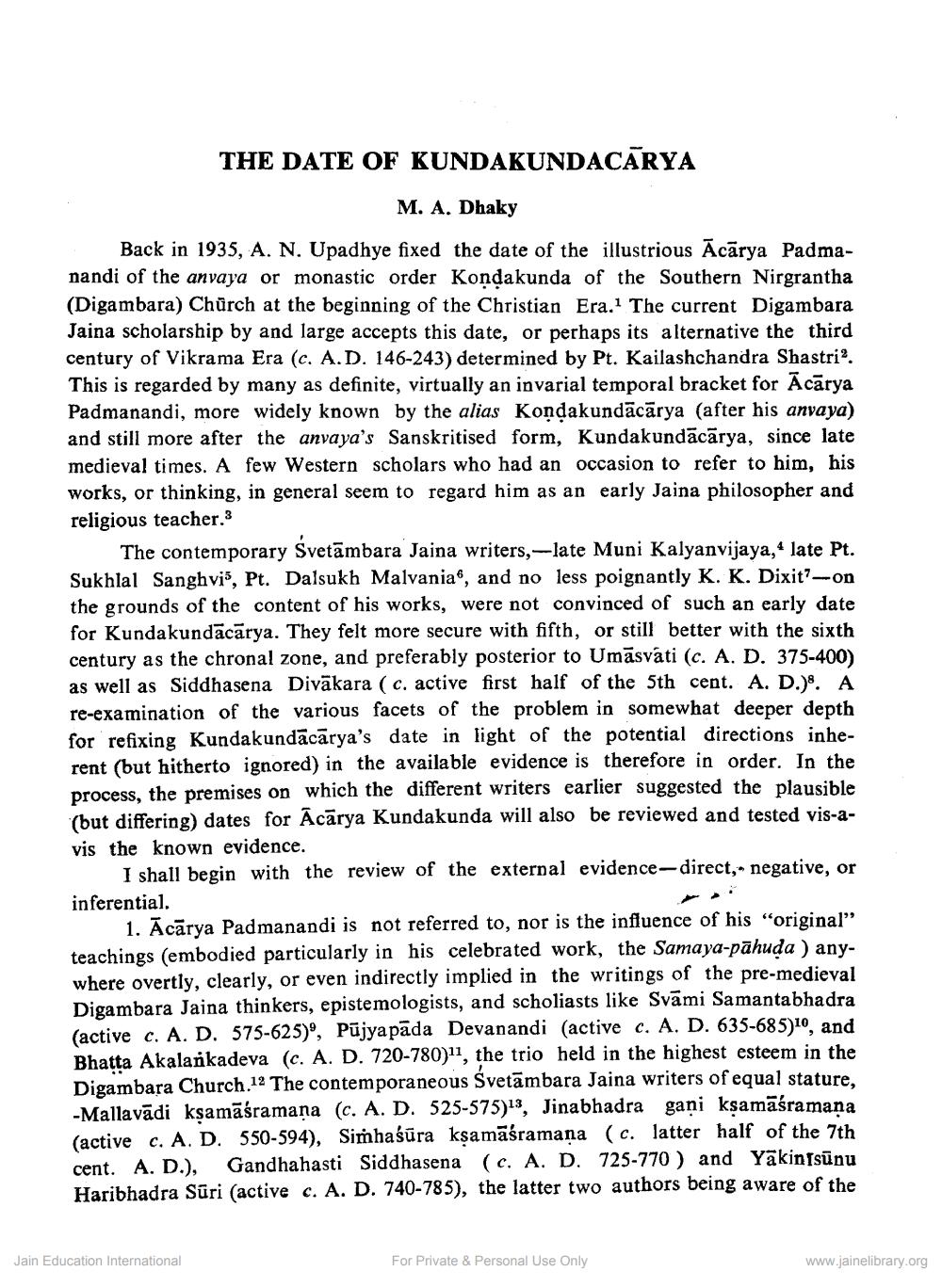Book Title: Date of Kundakundacharya Author(s): M A Dhaky Publisher: Z_Aspect_of_Jainology_Part_3_Pundit_Dalsukh_Malvaniya_012017.pdf View full book textPage 1
________________ THE DATE OF KUNDAKUNDACARYA M. A. Dhaky Back in 1935, A. N. Upadhye fixed the date of the illustrious Ācārya Padmanandi of the anvaya or monastic order Kondakunda of the Southern Nirgrantha (Digambara) Church at the beginning of the Christian Era. The current Digambara Jaina scholarship by and large accepts this date, or perhaps its alternative the third century of Vikrama Era (c. A.D. 146-243) determined by Pt. Kailashchandra Shastri'. This is regarded by many as definite, virtually an invarial temporal bracket for Acarya Padmanandi, more widely known by the alias Kondakundācārya (after his anvaya) and still more after the anvaya's Sanskritised form, Kundakundācārya, since late medieval times. A few Western scholars who had an occasion to refer to him, his works, or thinking, in general seem to regard him as an early Jaina philosopher and religious teacher.3 The contemporary Svetāmbara Jaina writers,-late Muni Kalyanvijaya, 4 late Pt. Sukhlal Sanghvi", Pt. Dalsukh Malvania, and no less poignantly K. K. Dixit-on the grounds of the content of his works, were not convinced of such an early date for Kundakundācārya. They felt more secure with fifth, or still better with the sixth century as the chronal zone, and preferably posterior to Umāsváti (c. A. D. 375-400) as well as Siddhasena Divākara ( c. active first half of the 5th cent. A. D.). A re-examination of the various facets of the problem in somewhat deeper depth for refixing Kundakundācārya's date in light of the potential directions inherent (but hitherto ignored) in the available evidence is therefore in order. In the process, the premises on which the different writers earlier suggested the plausible (but differing) dates for Ācārya Kundakunda will also be reviewed and tested vis-avis the known evidence. I shall begin with the review of the external evidence-direct, negative, or inferential. 1. Ācārya Padmanandi is not referred to, nor is the influence of his "original” teachings (embodied particularly in his celebrated work, the Samaya-pāhuda ) anywhere overtly, clearly, or even indirectly implied in the writings of the pre-medieval Digambara Jaina thinkers, epistemologists, and scholiasts like Svāmi Samantabhadra (active c. A. D. 575-625)", Pūjyapāda Devanandi (active c. A. D. 635-685)10, and Bhatta Akalarikadeva (c. A. D. 720-780)11, the trio held in the highest esteem in the Digambara Church.12 The contemporaneous Svetāmbara Jaina writers of equal stature, -Mallavādi ksamāśramana (c. A. D. 525-575)"3, Jinabhadra gani ksamāśramana (active c. A. D. 550-594), Simhaśūra ksamāśramana (c. latter half of the 7th cent. A. D.), Gandhahasti Siddhasena (c. A. D. 725-770 ) and Yakin[sūnu Haribhadra Sūri (active c. A. D. 740-785), the latter two authors being aware of the Jain Education International For Private & Personal Use Only www.jainelibrary.orgPage Navigation
1 2 3 4 5 6 7 8 9 10 11 12 ... 20
